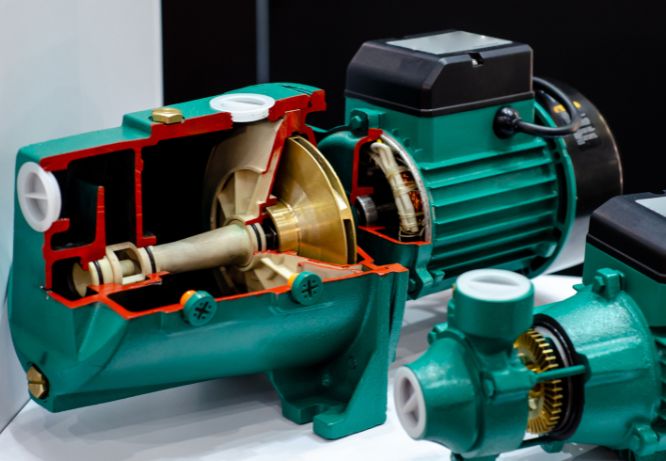
Centrifugal pumps are crucial for efficiently transferring fluids in countless applications, from household water systems to large-scale industrial processes. This blog delves into the essential aspects of centrifugal pumps, including their components, how they work, various types, and their applications.
Key Components of Centrifugal Pumps
Understanding the main components of centrifugal pumps is vital for both selecting the right pump and performing maintenance. Here are the core parts:
- Impeller: The heart of the centrifugal pump, the impeller is a rotating component that imparts energy to the fluid. Designed to accelerate the fluid outward from the center, it is often made from materials resistant to wear and corrosion.
- Casing: The casing surrounds the impeller and helps to convert the fluid’s velocity into pressure. It is essential for directing the flow of fluid through the pump and typically has a volute or diffuser to aid in pressure conversion.
- Shaft: This component connects the impeller to the motor, transferring mechanical energy. The shaft must be durable and well-aligned to avoid vibrations that can lead to premature failure.
- Bearings: Bearings support the rotating shaft, reducing friction and ensuring smooth operation. Regular maintenance is crucial to extend their lifespan and ensure optimal performance.
- Seals: Seals prevent leaks and protect the pump from contaminants. Common types include mechanical seals and gland packing. They are crucial for maintaining the pump’s efficiency and safety.
- Pump Casing Cover: The cover allows access to the impeller and other internal components for maintenance and inspection, ensuring that the pump operates correctly.
- Volute: This spiral-shaped component helps to convert the high-speed fluid from the impeller into a more manageable flow with increased pressure.
- Suction and Discharge Nozzles: These nozzles are where the fluid enters and exits the pump. Proper design is crucial to minimize turbulence and ensure efficient fluid transfer.
How Centrifugal Pumps Operate
Centrifugal pumps work on the principle of centrifugal force, which involves several key steps:
- Fluid Entry: Fluid enters the pump through the suction nozzle, moving into the casing and towards the impeller.
- Energy Transfer: As the impeller rotates, it imparts kinetic energy to the fluid, causing it to accelerate outward.
- Pressure Conversion: The accelerated fluid moves into the volute, where its velocity decreases and pressure increases due to the volute’s design.
- Fluid Discharge: The high-pressure fluid exits the pump through the discharge nozzle, ready for transport to its destination.
Types of Centrifugal Pumps
Centrifugal pumps come in several configurations, each suited to specific needs:
- Single-Stage Pumps: Ideal for applications requiring moderate pressure, single-stage pumps are straightforward and cost-effective. They are commonly used in domestic and industrial water supply systems.
- Multi-Stage Pumps: These pumps feature multiple impellers to achieve higher pressures. They are suitable for applications like high-pressure water supply and industrial processes.
- Peripheral Pumps: Designed for high pressure and low flow rates, peripheral pumps are used in applications requiring compact and efficient pressure generation.
- End-Suction Pumps: These horizontal pumps are versatile and used in various industrial and commercial applications due to their ease of maintenance and adaptability.
- Vertical Pumps: Vertical pumps are used when space is limited. They are often found in water and wastewater treatment facilities.
- Self-Priming Pumps: Capable of removing air from the suction line, self-priming pumps are used where the pump is located above the fluid source, such as in sewage systems.
Applications of Centrifugal Pumps
Centrifugal pumps are used in diverse fields due to their flexibility and efficiency:
- Water Supply: Essential in municipal water systems, irrigation, and water treatment plants.
- Chemical Processing: Handle various chemicals in the pharmaceutical, petrochemical, and manufacturing industries.
- HVAC Systems: Circulate water in heating, ventilation, and air conditioning systems, ensuring effective temperature control.
- Food and Beverage: Facilitate the transfer and processing of liquids such as juices, dairy products, and sauces.
- Oil and Gas: Manage crude oil, refined products, and chemicals in exploration and production environments.
- Mining: Handle slurries and other fluids in mining operations, ensuring efficient and reliable transport.
- Wastewater Management: Manage sewage, sludge, and other wastewater materials in treatment facilities.
Choosing a Reliable Pump Manufacturer
Selecting a reputable manufacturer is crucial for ensuring the reliability and performance of centrifugal pumps. Aashapuri Engineering Pvt Ltd stands out as a leading Centrifugal Pump Parts Manufacturer in India. They provide high-quality components, including:
- Centrifugal Pump Casings: Essential for directing fluid flow and converting velocity into pressure.
- Centrifugal Pump Plugs: Crucial for sealing and protecting pump components.
- Centrifugal Pump Parts: Comprehensive solutions for various pump needs.
Aashapuri Engineering Pvt Ltd is renowned for its expertise and commitment to quality. Their products are designed to meet stringent industry standards, ensuring durability and efficiency.
Conclusion
Centrifugal pumps are indispensable in many industries, providing efficient fluid transfer and pressure generation. Understanding their components, operation, types, and applications can help you make informed decisions about pump selection and maintenance. Partnering with a reputable manufacturer like Aashapuri Engineering Pvt Ltd ensures that you receive high-quality pump components tailored to your specific needs. Their expertise as a Centrifugal Pump Parts Manufacturer in India, along with their focus on Centrifugal Pump Casings and Centrifugal Pump Plugs, makes them a trusted choice for various industrial applications.
